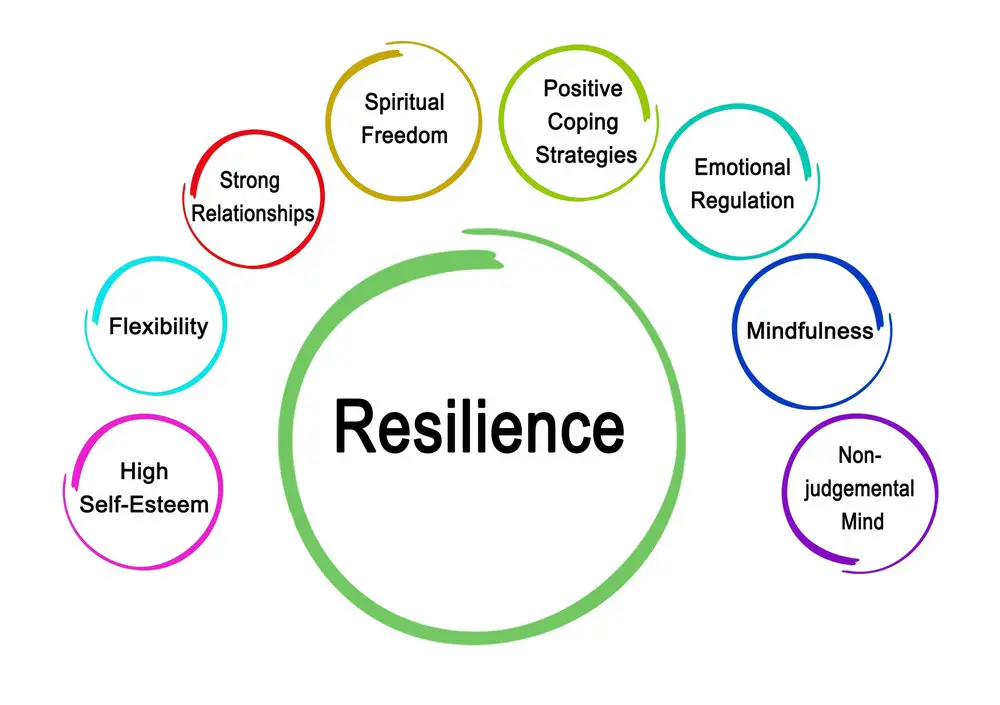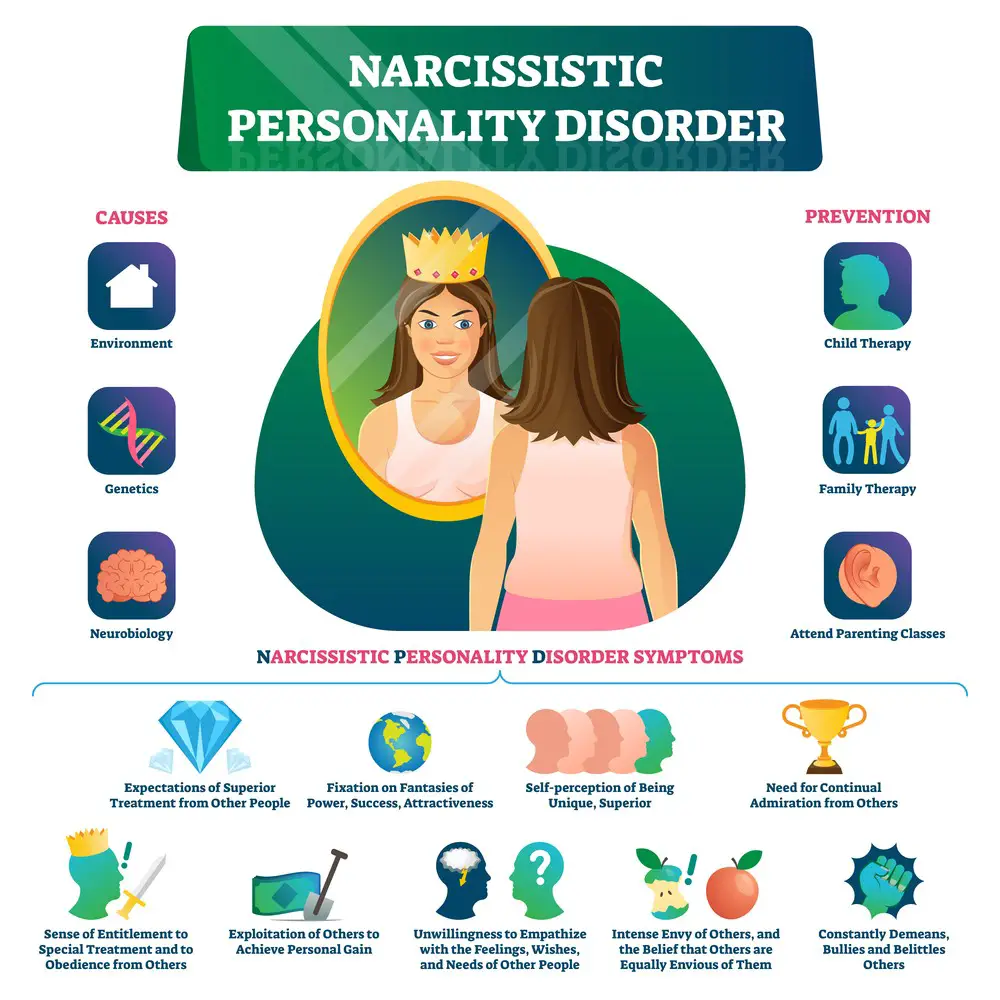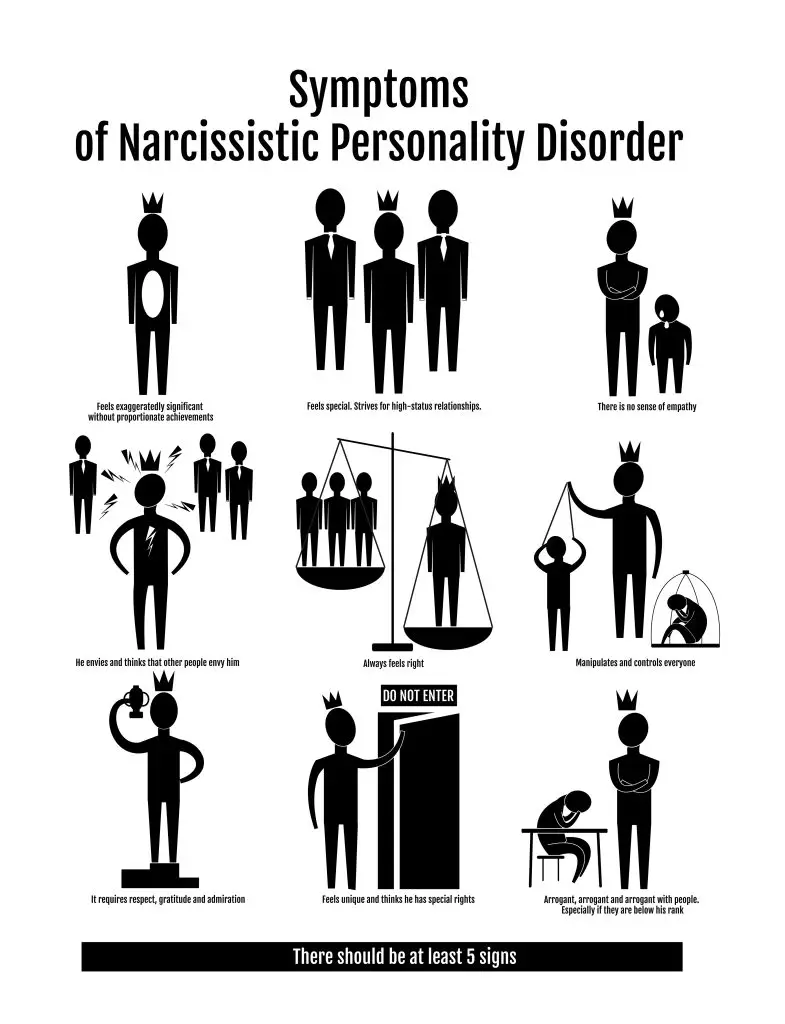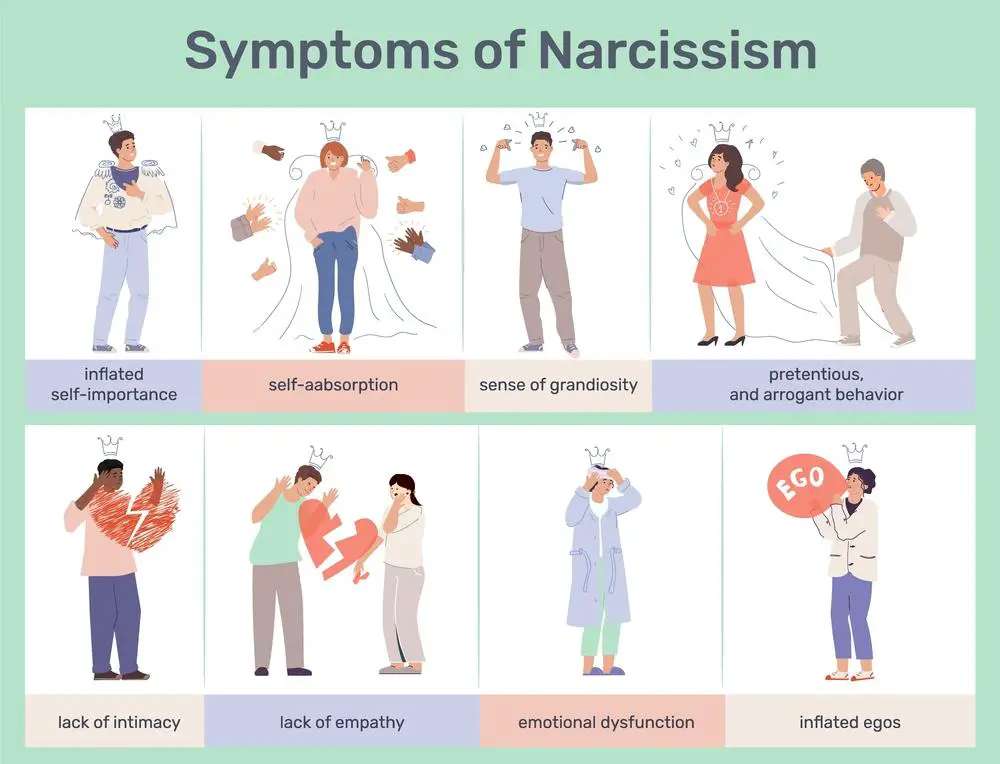As a BetterHelp affiliate, we receive compensation from BetterHelp if you purchase products or services through the links provided
Narcissism is a personality trait that involves a heightened sense of self-importance and a deep need for excessive attention and admiration. It is found in both genders, but the traits can be especially pronounced and distinct in females. When a woman exhibits narcissistic tendencies, they often shape her interactions and relationships in complex ways. While the term ‘narcissist’ may conjure up an image of a self-centered individual, in females, these behaviors and attitudes can be more subtle and socially conditioned.
It’s essential to recognize that narcissism transcends mere vanity or self-absorption. It’s a consistent pattern of behavior that affects how a woman sees herself and others. Female narcissists may often appear charming and confident, but underneath that facade, they might struggle with vulnerability and empathy. From personal to professional environments, understanding how these traits manifest in women is essential for recognizing potential signs in others and reflecting on one’s behavior.
Narcissistic Personality Disorder (NPD) is a diagnosable mental condition that requires a comprehensive assessment by a mental health professional. However, not every individual showing traits of narcissism has NPD. The spectrum of narcissistic behaviors can vary widely, from benign self-concern to severe interpersonal dysfunction. Knowing more about this condition can help in navigating relationships with those who have narcissistic solid traits and understanding the dynamics at play.
Key Takeaways
- Narcissism in women encompasses a pattern of self-important behavior and a need for admiration.
- Female narcissists may present with charm and confidence while struggling with empathy.
- Narcissistic Personality Disorder is a diagnosable condition, distinct from displaying narcissistic traits.
 Understanding Narcissism and Its Manifestation in Females
Understanding Narcissism and Its Manifestation in Females
Narcissistic Personality Disorder is a condition marked by an inflated sense of self-importance. It can manifest distinctly in females, with societal norms and gender roles often influencing its expression.
Defining Narcissistic Personality Disorder
Narcissistic Personality Disorder (NPD) is a mental health condition characterized by a long-term pattern of exaggerated feelings of self-importance and a deep need for excessive attention and admiration. Those with NPD often lack empathy for others and harbor fantasy beliefs surrounding their own success, beauty, or power.
Key traits include:
- A heightened sense of entitlement
- Needing constant praise and admiration
- Experiencing intense envy or believing others are envious of them
It’s important to remember that NPD is a diagnosable condition, and only a qualified professional can accurately pinpoint its presence.

Gender Differences in Narcissism
Research indicates that narcissism may be expressed differently across genders due to various factors, including societal expectations and upbringing. While males might display narcissism through overt assertiveness and aggression, females often exhibit what’s called covert narcissism. Covert narcissism in females can include:
- Subtler forms of manipulation
- Passive-aggressive behaviors
- A focus on appearance and status to gain admiration
Moreover, how society reacts to assertive behaviors in women can affect how symptoms are perceived and labeled. Women might be more likely to internalize narcissistic wounds and could display hypersensitivity to how others perceive them.
Remember, comprehending these nuances is vital in recognizing and understanding narcissism in females and that every individual case can present unique characteristics.
 Core Characteristics of Female Narcissists
Core Characteristics of Female Narcissists
Understanding female narcissists means recognizing their core characteristics. These individuals often display distinct tendencies that set them apart.
Need for Admiration and Attention
A defining trait of a female narcissist is an insatiable need for admiration and attention. You might notice these behaviors:
- Excessive concern with appearance and status indicators.
- Frequently demands compliments and positive reinforcement from others.
Key Takeaway: Your awareness of their constant need for approval can help you navigate interactions with female narcissists.
Lack of Empathy and Emotional Involvement
Female narcissists may struggle with genuine empathy, which is crucial for deep connections. Indicators include:
- Difficulty acknowledging and responding to other people’s feelings.
- Relationships often centered around their own needs rather than mutual support.
Key Takeaway: Recognizing their limited emotional involvement can steer you towards healthier reciprocal relationships.
 Behaviors and Interpersonal Relationships
Behaviors and Interpersonal Relationships
Female narcissists often exhibit distinct behaviors in their interactions with others. These can significantly affect both their romantic and family relationships.
Manipulation Tactics
Female narcissists may use a variety of manipulation tactics to exert control over their relationships.
- Gaslighting: You might encounter a situation where your perception of reality is constantly challenged, leaving you doubtful of your own memories or thoughts.
- Triangulation: Expect situations where she introduces another person into the dynamic, creating competition and fueling a sense of insecurity in you.
Key takeaway: Be aware that manipulation can wear down your self-esteem and skew your perception of what’s normal in a relationship.
Impact on Romantic and Family Relationships
The impact on relationships due to the manipulative behaviors of female narcissists is profound.
- In romantic relationships, you might feel consistently undermined as your partner seeks admiration and attention from others, negating the value of your own needs and feelings.
- Children of narcissistic mothers may often feel that they are never good enough due to the high expectations and criticism they face, affecting their emotional well-being.
Key takeaway: Maintaining your self-worth and setting boundaries are essential in relationships with female narcissists.
 Expressions of Narcissism in Various Settings
Expressions of Narcissism in Various Settings
Narcissistic traits can manifest distinctly across different environments, each setting amplifying different aspects of behavior. Certain traits are more visible at the workplace, while others come to the fore through social media interactions.
At Work and in Social Circles
In professional environments and social gatherings, individuals with narcissistic traits might exhibit a strong need for admiration and a sense of superiority.
- Work: At your job, such a colleague may be competitive, often seeking to undermine others to highlight their achievements. They may:
- Insist on having the best projects or assignments
- The desire for constant recognition from superiors
- Use others to climb the corporate ladder, showing little regard for teamwork
- Control and Status: The drive for control can be evident in how they network, presenting themselves as highly important. They often focus on associating with high-status individuals who can elevate their perceived self-worth.
Key Takeaway: When you’re dealing with narcissistic behaviors at work or in social circles, stay aware of manipulative tactics that might undermine your efforts or self-confidence.
 Online and Through Social Media
Online and Through Social Media
The digital realm offers another canvas for narcissistic expressions where typical behaviors are magnified, and the pursuit for attention is relentless.
- Social Media: Here, an individual may curate a persona that exudes perfection and success. They might:
- Post frequent selfies or updates seeking validation
- Respond negatively to comments that don’t affirm their views or image
- Control: On these platforms, controlling the narrative of one’s life is easier. They can remove unflattering comments or block dissenting voices to maintain an idealized image.
Key Takeaway: If you encounter narcissistic behavior online, it’s essential to remember that social media is often a highlight reel, not an accurate depiction of real life.
 The Psychological Underpinnings of Narcissism
The Psychological Underpinnings of Narcissism
Narcissism is rooted in complex psychological processes. The way individuals with narcissistic traits interact with the world often stems from their internal perceptions of self-esteem and their developmental experiences. Understanding these underpinnings can shed light on their behaviors and motivations.
Self-Esteem and Insecurity Issues
- Self-Esteem: You might notice that narcissists appear to have an inflated sense of self-importance. This can mask low self-esteem, a core component of narcissistic behavior. Narcissists often rely on external validation to bolster their self-worth and may react negatively when they don’t receive the admiration they expect.
- Example: A narcissist might frequently seek compliments on their appearance or achievements.
- Insecurity: Despite the outer display of confidence, deep-seated insecurities are common in individuals with narcissistic traits. These insecurities drive the need for attention and affirmation.
- Sign: You may observe a tendency to devalue others to cope with envy and defend against feelings of inadequacy.
Key Takeaway: It’s essential to recognize that the grandiosity exhibited by a narcissist often hides underlying insecurities.
Origins and Development of Narcissistic Traits
- Causes: The causes of narcissistic traits are multifaceted and may include childhood experiences such as excessive pampering or extreme criticism, genetic factors, and social influences.
- Influence of Parenting Styles: Certain parenting styles, like being overly indulgent or excessively demanding, can contribute to the development of narcissism.
- Development: Narcissistic traits typically develop through a complex interaction of these factors during critical periods of personality development in childhood and adolescence.
- Cultural Impact: Societal values that emphasize success, beauty, and personal gain over community-centric values can fuel narcissistic behaviors.
Key Takeaway: Understanding the origins of narcissistic traits helps in comprehending the complexity of the disorder and the potential pathways for addressing it.
 Comparative Analysis of Narcissism
Comparative Analysis of Narcissism
In this exploration, we focus on the nuances between male and female expressions of narcissism and the distinction between its covert and overt forms. The insights here are tailored to enhance your understanding of these complex dynamics.
Female vs. Male Narcissistic Behaviors
Differences in Expression:
Females with narcissistic traits might often exhibit empathy in social settings, but this is usually for self-serving reasons. They may use soft power, such as emotional manipulation, to maintain their self-image and superiority. Males, on the other hand, tend to wield more overt forms of dominance or entitlement, such as direct aggression or exploitation.
- Social Dynamics: Females often manipulate social networks to gain favor, while males may prioritize status and power.
- Relationship Patterns: Female narcissists might focus on appearance and social capital, whereas males may emphasize control and authority.
Key Takeaway: Your interactions might reveal subtle power plays with female narcissists, while with male narcissists, the power dynamics are often more front-and-center.
Understanding Covert and Overt Narcissism
Defining the Terms:
- Overt Narcissism: Characterized by grandiosity, attention-seeking, and a sense of entitlement. It’s straightforward and conspicuous.
- Covert Narcissism: More subtle and marked by hypersensitivity, defensiveness, and a propensity for playing the victim.
Gender-specific Manifestations:
- Females are often thought to lean towards covert narcissism, showcasing vulnerability to garner attention and support. However, this doesn’t preclude them from overt displays.
- Males may predominantly demonstrate overt narcissism, characterized by boldness and an unabashed pursuit of power.
Key Takeaway: As you navigate relationships, pay attention to overt signs of bold confidence and covert cues of hidden agendas.
 Confronting and Responding to Narcissism
Confronting and Responding to Narcissism
In dealing with narcissistic behavior, especially in women, it’s crucial to know practical ways to respond. Your well-being comes first, so let’s explore how to manage these challenging scenarios.
Setting Boundaries
You can’t change others but can change how you interact with them. Setting firm boundaries is vital:
- Identify your limits: Clearly define what you are and aren’t willing to tolerate.
- Communicate your boundaries: Calmly convey these limits to the narcissist without accusation.
- Stick to your boundaries: Be consistent. If a line is crossed, take the agreed-upon action.
Key Takeaway: Boundaries help you maintain your dignity and control in interactions. Stay consistent, and don’t hesitate to enforce them.
Dealing with Manipulative Behaviors
Narcissists may use manipulation to hold power. Here’s how to handle it:
- Stay calm: Don’t let your emotions dictate your response to manipulative tactics.
- Recognize the patterns: Be aware of when and how manipulation occurs.
- Recognize aggressive or rage-filled outbursts as tactics to unnerve you; maintain your composure.
- Focus on facts: Keep conversations based on facts, not personal feelings, to deflect manipulation.
- Seek support: Consult with a therapist or support group to navigate through manipulative behavior.
Key Takeaway: Dealing with manipulation requires a steady approach. Be attentive to patterns, stand by the facts, and seek support when needed.
 Potential Consequences of Narcissistic Abuse
Potential Consequences of Narcissistic Abuse
When you’re dealing with narcissistic abuse, it’s important to understand the deep and lasting effects it can have on your well-being. Here’s what you might experience:
Emotional and Psychological Impact
- Self-Esteem: Narcissistic abuse can leave you with feelings of worthlessness and an eroded sense of self-esteem.
- Trust Issues: You may find it hard to trust others, fearing future manipulation or betrayal.
Key Takeaway: Protecting and rebuilding your emotional health is crucial after such experiences.
Long-term Effects on Victims
- Mental Health: Anxiety, depression, and PTSD can be long-standing companions in your journey post-abuse.
- Relationship Patterns: Without awareness, you might find yourself in similar toxic dynamics in the future.
Key Takeaway: Awareness and support can help in navigating the aftermath of abuse and in forming healthier connections.
 Diagnosis and Assessment of Narcissistic Personality Disorder
Diagnosis and Assessment of Narcissistic Personality Disorder
When exploring Narcissistic Personality Disorder (NPD), you’ll want to understand the criteria used for diagnosis, as well as the methods professionals employ to assess the disorder.
Utilizing Diagnostic Criteria
Narcissistic Personality Disorder is identified by a pattern of grandiosity, a need for admiration, and a lack of empathy that begins by early adulthood and presents in various contexts, as indicated by five (or more) of the following traits:
- A grandiose sense of self-importance
- Preoccupation with fantasies of unlimited success, power, brilliance, beauty, or ideal love
- The belief that one is special and can only be understood by, or should associate with, other special or high-status people (or institutions)
- A need for excessive admiration
- A sense of entitlement (unreasonable expectations of especially favorable treatment or automatic compliance with one’s expectations)
- Interpersonally exploitative behavior (taking advantage of others to achieve one’s ends)
- A lack of empathy, unwillingness to recognize or identify with the feelings and needs of others
- Envy of others or a belief that others are envious of them
- Arrogant and haughty behaviors or attitudes
Key Takeaway: These criteria, especially when persistent and spanning various life areas, may suggest the possibility of NPD and warrant a more thorough professional assessment.
Professional Assessment Methods
Healthcare professionals assess NPD using a blend of strategies:
- Clinical Interviews: Detailed conversations to understand the individual’s behavior, emotions, and relationships.
- Psychological Evaluation: Incorporating standardized psychological tests and personality assessments to gather comprehensive information.
- Observation: Their behavior patterns and interactions in different scenarios and compared them with NPD criteria.
- Differential Diagnosis: Ensuring symptoms are not better explained by other personality disorders, especially other Cluster B personality disorders, or by medical conditions.
Remember, a trained professional can only make a reliable diagnosis following extensive evaluation. Self-diagnosis or identifying others without proper assessment can lead to misinformation and may be harmful.
Key Takeaway: If you suspect you might have traits consistent with NPD, consider reaching out to a mental health professional who can provide an informed diagnosis and suggest the appropriate path for support or treatment.
 Navigating Treatment and Support Options
Navigating Treatment and Support Options
When you’re ready to seek aid for narcissistic traits, knowing your treatment and support options is vital. They are valuable tools that can guide you towards a healthier mindset and improved relationships.
Therapeutic Approaches
In therapy, your journey is unique. You’ll likely explore a range of treatments tailored to your needs, such as:
- Cognitive Behavioral Therapy (CBT): You’ll work to identify negative thought patterns and replace them with positive ones, improving your interactions and self-perception.
- Dialectical Behavior Therapy (DBT): This therapy enhances your emotional regulation and teaches you skills to manage stress and improve relationships.
Key Takeaway: Therapy is your growth path, with various approaches like CBT and DBT that help reshape harmful narratives and behaviors.
Support Networks and Resources
You don’t have to walk this path alone. Reach out for:
- Support Groups: Connect with peers who understand your struggles. They can provide a sense of community and joint learning.
- Professional Guidance: Licensed therapists or counselors can offer expertise and structured support, helping you to navigate your emotions and relationships.
Key Takeaway: Support networks provide a foundation of understanding and accountability, while professional resources offer expert guidance tailored to your journey.
Future Directions in Understanding and Managing Narcissism
In the journey to grasp and handle narcissistic traits, especially in women, the road ahead is paved with innovative research and bolstered public engagement. These elements are crucial for fostering a comprehensive approach to this personality phenomenon.
Research Trends
The latest trends in research are honing in on the nuances of narcissism, shifting beyond just identification to understanding the root causes and effective management strategies. You’ll discover:
- Improved Diagnostic Tools: New methods to diagnose narcissism that are gender-sensitive and nuanced, particularly tailored for women.
- Genetic and Environmental Factors: A deep dive into how these elements influence the development of narcissistic traits.
- Therapeutic Interventions: The ongoing development of specific interventions aims at helping women with narcissistic traits to foster healthier relationships and self-perceptions. These include:
- Cognitive Behavioral Therapy (CBT)
- Dialectical Behavior Therapy (DBT)
- Group therapy sessions explicitly tailored for narcissism
Key Takeaway: Research is getting laser-focused on gender-specific indicators and treatment of narcissism.
Public Awareness and Education
Anchoring awareness and education in everyday discourse is essential. Your awareness can be the catapult for change:
- Educational Campaigns: Initiatives that aim to inform the public about the signs of narcissism and its impact on individuals and their loved ones.
- School-Based Programs: Development of curriculum components for younger audiences to encourage early detection and healthy coping strategies.
- Media Representation: Encouraging responsible and accurate depictions of narcissism in entertainment and news media to destigmatize those living with it and promote a more nuanced understanding.
Key Takeaway: Empower yourself and others through increased education and awareness about narcissism, leading to a more supportive environment for managing these traits.
Frequently Asked Questions
When you’re trying to understand a female narcissist, it’s crucial to look at specific behaviors and interaction patterns. Here, you’ll find clear-cut answers to some common questions that may shed light on what you’re dealing with.
What are common behaviors exhibited by female narcissists in relationships?
Female narcissists might demonstrate an exaggerated sense of entitlement, requiring constant admiration and having little regard for your feelings. They could belittle you to elevate themselves and insist on having the best of everything. Remember, behind that facade often lies a delicate self-esteem, vulnerable to the slightest criticism.
Key takeaway: Female narcissists often need excessive admiration and can be insensitive to their partners’ feelings.
How does one recognize gaslighting techniques used by female narcissists?
Gaslighting by a female narcissist may begin subtly. She could outright deny saying something, even though you clearly remember it, or she might accuse you of being overly sensitive when you point out her hurtful remarks. Your reality feels undermined, making you second-guess your memory and perception. If you’re feeling confused and doubting yourself more than usual, that’s a red flag.
Key takeaway: Trust your instincts; persistent confusion and self-doubt can signal gaslighting.
In what ways can a covert female narcissist’s behavior differ from more overt manifestations?
Covert female narcissists often mask their self-centered behavior with shyness or a façade of caring. Unlike their overt counterparts, they might not openly brag, but they manipulate situations subtly to get attention and admiration. They might play the victim or use passive-aggressive tactics to achieve their aims.
Key takeaway: Covert narcissists may not be as obvious, employing subtler tactics to fulfill their need for attention.
What are typical ways female narcissists treat their partners?
In relationships, a female narcissist might treat you as an extension of themselves rather than as an individual with your own needs. Common treatments include:
- Expecting you to meet their needs without reciprocation.
- Showing jealousy or competitiveness, even against your accomplishments.
- Devaluing your feelings and experiences if they don’t align with their own.
Key takeaway: Your needs are often sidelined as a female narcissist prioritizes her own.
Are there any specific traits that distinguish female narcissists over 50?
With age, some female narcissists might become more domineering or set in their ways. They might dismiss new ideas or people that don’t fit their established worldview. Some could also leverage age and experience to assert their superiority.
Key takeaway: Older female narcissists might use their age as a basis for asserting authority.
Can you identify any unique methods of dealing with female narcissists effectively?
Dealing with female narcissists requires a measured approach:
- Set clear boundaries; decide what behavior you will not tolerate.
- Focus on facts rather than emotions when discussing issues.
- Realize that their lack of empathy isn’t a reflection of you.
Key takeaway: Protect your well-being by setting boundaries and communicating factually.

Bio: Jacob Maslow – Navigating Through Narcissism
Personal Journey with Narcissistic Abuse
- Challenges in Co-Parenting: My ex-partner’s refusal to cooperate in reunification therapy led to the end of our children’s alienation. This marked a significant turn in our post-divorce journey.
- Mental Health Advocacy: I actively manage my mental health through medication (Lexapro) and therapy. Recently, I’ve embraced online platforms like BetterHelp for continued support.
Exposure to Narcissistic Traits
- Living with a Narcissist: My ex’s behavior is a textbook example of narcissism – from pursuing affairs with community leaders to launching smear campaigns against them.
- Intensifying Struggles: Post-divorce, her narcissistic traits have amplified, leading to complete alienation of our children and non-compliance with custody orders.
Coping and Healing
- Finding Solace in Routine: Daily long walks have become my sanctuary, helping me to stay grounded and clear my mind amidst ongoing legal battles.
- Writing as a Form of Support: Through my articles on mental health and narcissism, I aim to help others facing similar struggles with narcissistic partners.
Legal and Emotional Support
- Legal Expertise for Others: On my legal site, I guide others whose spouses defy court orders and use children as pawns, sharing insights from my experience.
- Personal Impact: Losing a close relationship with my children recently has been a profound challenge, reinforcing my commitment to advocating for mental health and a better understanding of narcissism.
In this bio, I share my experiences and insights, hoping to provide support and understanding for others navigating similar challenges. My journey through the complexities of narcissistic relationships and mental health struggles underscores my commitment to helping others find their path to healing and empowerment.

- Breaking the Silence: Why Men’s Mental Health Matters More Than Ever - April 15, 2025
- How to Transform a Home’s Patio Space into a Relaxing Space - March 23, 2025
- 5 Strategies to Use a Cell Phone to Help Manage Your Stress - March 23, 2025
This site contains affiliate links to products. We will receive a commission for purchases made through these links.


 Understanding Narcissism and Its Manifestation in Females
Understanding Narcissism and Its Manifestation in Females Core Characteristics of Female Narcissists
Core Characteristics of Female Narcissists Behaviors and Interpersonal Relationships
Behaviors and Interpersonal Relationships Expressions of Narcissism in Various Settings
Expressions of Narcissism in Various Settings Online and Through Social Media
Online and Through Social Media The Psychological Underpinnings of Narcissism
The Psychological Underpinnings of Narcissism Comparative Analysis of Narcissism
Comparative Analysis of Narcissism Confronting and Responding to Narcissism
Confronting and Responding to Narcissism Potential Consequences of Narcissistic Abuse
Potential Consequences of Narcissistic Abuse Diagnosis and Assessment of Narcissistic Personality Disorder
Diagnosis and Assessment of Narcissistic Personality Disorder Navigating Treatment and Support Options
Navigating Treatment and Support Options
